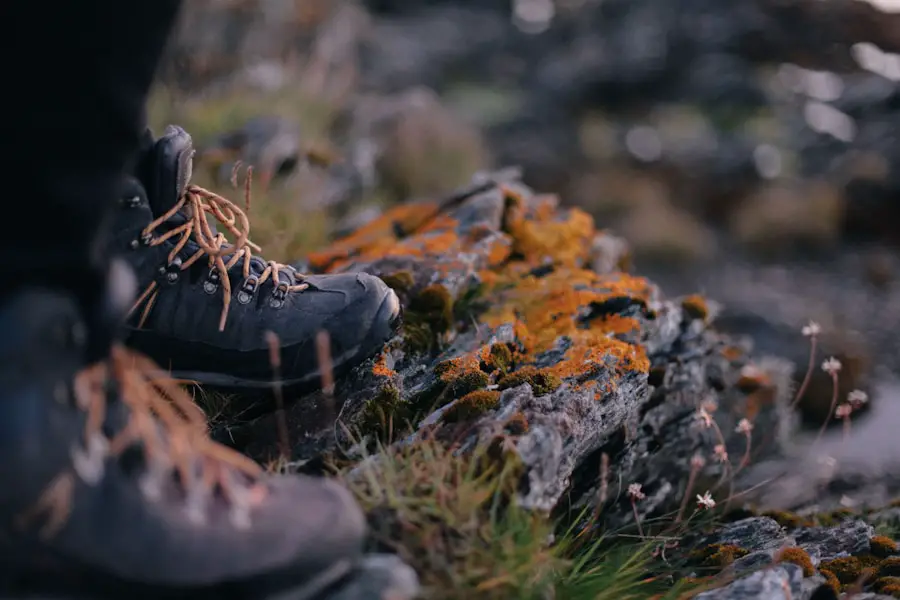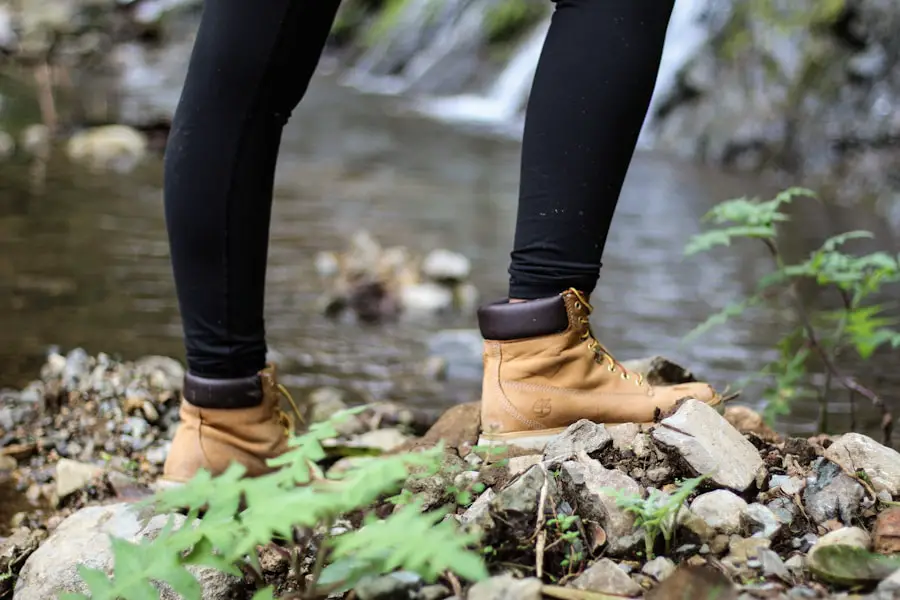Hiking boots are an essential piece of gear for any outdoor enthusiast, providing the necessary support and protection for the feet during long treks. However, even the best hiking boots can sometimes feel restrictive or uncomfortable, especially when they are new. This is where the importance of stretching comes into play.
Properly stretching hiking boots can enhance comfort, improve fit, and ultimately lead to a more enjoyable hiking experience. When boots are too tight, they can cause blisters, calluses, and other foot ailments that can ruin a hike. By taking the time to stretch your boots, you can ensure that they conform to the unique shape of your feet, allowing for better circulation and reducing the risk of injury.
Moreover, stretching hiking boots can also extend their lifespan. Boots that fit well are less likely to experience undue wear and tear, as they will not be subjected to excessive friction or pressure points. This is particularly important for those who frequently hike in rugged terrains where the boots are put to the test.
A well-stretched boot will not only feel better but will also perform better, providing the necessary support and stability needed for challenging trails. Therefore, understanding how to properly stretch hiking boots is crucial for both comfort and durability.
Key Takeaways
- Stretching hiking boots is important for preventing blisters and discomfort on the trail
- Properly stretching hiking boots involves using the right tools and techniques to avoid damaging the material
- When choosing hiking boots, consider factors such as fit, support, and waterproofing to ensure a comfortable and safe hiking experience
- Stretching can help alleviate common foot problems such as bunions, corns, and hammertoes when wearing hiking boots
- DIY methods for stretching hiking boots include using a boot stretcher, wearing thick socks, and using a hairdryer to heat and stretch the material
How to Properly Stretch Hiking Boots
To effectively stretch hiking boots, it is essential to first identify the areas that require adjustment. Many hikers experience discomfort in specific spots, such as the toe box or around the arch. Once these areas are pinpointed, various methods can be employed to achieve a better fit.
One common approach is to wear thick socks while walking around the house in the boots. This method allows the material to gradually stretch and mold to the shape of your feet. It is advisable to start with short periods of wear and gradually increase the duration as your feet become accustomed to the pressure.
Another effective technique involves using a boot stretcher, a tool specifically designed for this purpose. Boot stretchers come in various forms, including those that target width or length. By inserting a boot stretcher into the boot and adjusting it to apply gentle pressure, you can create more space in tight areas.
For best results, consider leaving the stretcher in place overnight or for several hours to allow the material to adapt. Additionally, applying a leather stretching spray can help soften the material, making it more pliable and easier to stretch.
Tips for Choosing the Right Hiking Boot

Selecting the right hiking boot is a critical step in ensuring comfort and performance on the trail. One of the first considerations should be the type of hiking you plan to do. For instance, if you intend to tackle rugged terrains with heavy loads, opt for boots that offer robust ankle support and a durable sole.
Conversely, if your hikes are more casual or involve lighter loads, a low-cut shoe may suffice. Understanding your hiking style will guide you toward the appropriate boot type. Fit is another paramount factor when choosing hiking boots.
It is advisable to try on boots at the end of the day when your feet are slightly swollen from daily activities. This ensures that you select a size that accommodates any natural swelling that occurs during hikes. Pay attention to the toe box; there should be enough room for your toes to wiggle without feeling cramped.
Additionally, consider the width of your foot; some brands offer wide options for those with broader feet. Finally, don’t forget to test the boots on an incline to assess how they feel when walking uphill or downhill, as this can significantly impact comfort during actual hikes.
Common Foot Problems and How Stretching Can Help
| Foot Problem | Prevalence | Stretching Benefit |
|---|---|---|
| Plantar Fasciitis | 10% of population | Stretching can help reduce pain and improve flexibility |
| Bunions | 23% of adults | Stretching can help relieve pressure and improve joint mobility |
| Flat Feet | 30% of population | Stretching can strengthen arch muscles and improve foot alignment |
| Hammertoes | 7% of population | Stretching can help prevent stiffness and improve toe flexibility |
Hikers often encounter various foot problems that can hinder their enjoyment of outdoor activities. Blisters are perhaps the most common issue, typically caused by friction between the skin and boot material. When boots are too tight or poorly fitted, they exacerbate this problem by creating pressure points that lead to painful blisters.
Stretching your hiking boots can alleviate these pressure points by providing a more comfortable fit, thereby reducing friction and minimizing the risk of blisters. Another prevalent issue is plantar fasciitis, characterized by pain in the heel and bottom of the foot due to inflammation of the plantar fascia ligament. Tight-fitting boots can contribute to this condition by failing to provide adequate arch support or cushioning.
By stretching your boots, particularly around the arch area, you can create a more supportive environment for your feet. This adjustment can help distribute weight more evenly across your foot and reduce strain on the plantar fascia, ultimately leading to a more comfortable hiking experience.
DIY Methods for Stretching Hiking Boots
For those who prefer a hands-on approach, several DIY methods can effectively stretch hiking boots at home. One popular technique involves using water to soften the material before stretching. Fill a spray bottle with water and lightly mist the areas of the boot that feel tight.
After dampening the material, wear thick socks and put on the boots while they are still wet. Walk around in them until they dry; this method allows the boots to mold to your feet as they dry. Another DIY method involves using heat to stretch leather or synthetic materials.
Using a hairdryer on a low setting, apply heat directly to the tight areas of the boot while flexing and moving your foot inside. The heat will soften the material, making it more pliable for stretching. Be cautious not to overheat any one area, as this could damage the boot’s integrity.
After applying heat, wear thick socks and walk around until the material cools down and retains its new shape.
Professional Methods for Stretching Hiking Boots

While DIY methods can be effective, sometimes professional assistance is warranted for optimal results. Many outdoor retailers offer boot stretching services performed by trained staff who understand how different materials respond to stretching techniques. These professionals often use specialized equipment designed for stretching boots without compromising their structure or support.
One common professional method involves using a hydraulic boot stretcher that applies even pressure across specific areas of the boot. This method is particularly useful for addressing stubborn tight spots that DIY methods may not fully resolve. Additionally, professionals may use stretching solutions that penetrate deeper into the material than typical household products, ensuring a more thorough stretch without damaging the boot.
Maintaining the Shape and Support of Hiking Boots
Once you have successfully stretched your hiking boots for a better fit, it is crucial to maintain their shape and support over time. Regular cleaning is essential; dirt and debris can accumulate in crevices and affect how well your boots fit and function. Use a soft brush or cloth to remove dirt after each hike and consider using specialized cleaning products designed for hiking footwear.
Proper storage also plays a significant role in maintaining boot shape. Avoid leaving your boots in direct sunlight or damp environments, as these conditions can warp materials or promote mold growth. Instead, store them in a cool, dry place with adequate ventilation.
Using boot trees or stuffing them with newspaper can help retain their shape when not in use.
Additional Foot Care Tips for Happy Hiking
In addition to ensuring your hiking boots fit well through stretching and maintenance, taking care of your feet is equally important for an enjoyable hiking experience. Start by investing in high-quality moisture-wicking socks designed specifically for hiking; these socks help keep your feet dry and reduce friction that leads to blisters. Regular foot inspections before and after hikes can also help catch any potential issues early on.
Look for signs of redness or irritation that may indicate developing blisters or other problems. If you notice any discomfort during a hike, take breaks as needed to adjust your footwear or address any issues before they escalate. Lastly, consider incorporating foot exercises into your routine to strengthen foot muscles and improve flexibility.
Simple exercises like toe curls or calf stretches can enhance overall foot health and prepare them for long hikes ahead. By combining proper boot care with diligent foot care practices, you can ensure many happy miles on the trails ahead.
If you’re planning a hiking trip and need to stretch out your boots for a more comfortable fit, check out this helpful article on how to stretch hiking boots. This guide offers tips and tricks for expanding the size of your footwear to prevent blisters and discomfort while on the trails. Whether you’re breaking in new boots or need to adjust the fit of your current pair, these methods will ensure your feet stay happy during your outdoor adventures.
FAQs
What are the benefits of stretching hiking boots?
Stretching hiking boots can help improve the fit and comfort of the boots, reduce the risk of blisters and hot spots, and provide better support for your feet during long hikes.
How can I stretch my hiking boots?
There are several methods to stretch hiking boots, including using a boot stretcher, wearing thick socks and walking in the boots, using a stretching spray, or using a hairdryer to heat and stretch the material.
Can I stretch my hiking boots at home?
Yes, you can stretch your hiking boots at home using various methods such as using a boot stretcher, wearing thick socks and walking in the boots, or using a stretching spray. However, it’s important to follow the manufacturer’s guidelines and not overstretch the boots.
How long does it take to stretch hiking boots?
The time it takes to stretch hiking boots can vary depending on the method used and the material of the boots. It can take anywhere from a few hours to a few days for the boots to stretch and mold to your feet.
Are there any risks to stretching hiking boots?
There is a risk of overstretching the boots, which can cause them to lose their shape and support. It’s important to follow the manufacturer’s guidelines and not force the boots to stretch beyond their natural limits.
